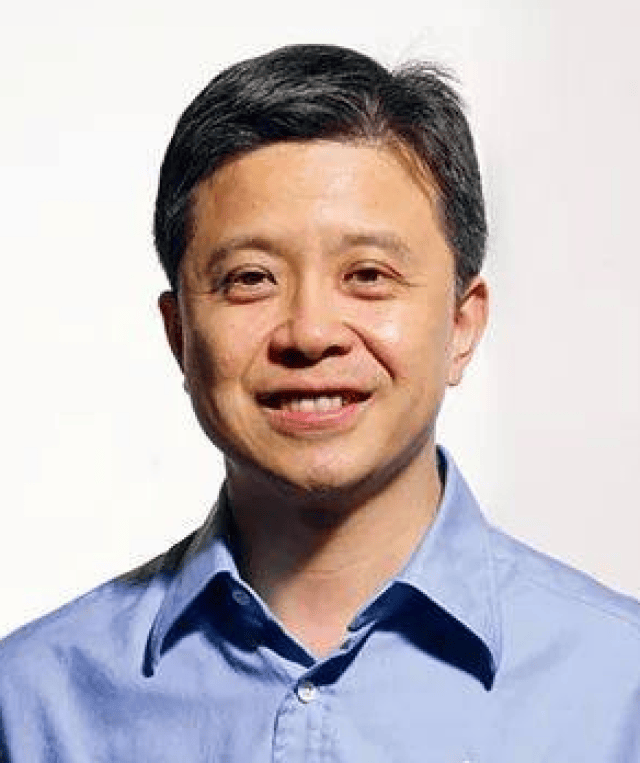AI Conference Beijing O'Reilly and Intel Artificial Intelligence Conference topics announced!
The first AI Conference Beijing Station promises:
It will bring you an unprecedented gathering of the world's leading artificial intelligence innovators, allowing China's artificial intelligence talents to communicate face-to-face with global artificial intelligence thought leaders.
The Beijing Artificial Intelligence Conference focused on a unique focus: applied artificial intelligence. This focus bridges the development of AI research with its real-world applications in business and industry.
AI Conference Beijing Station is co-sponsored by O'Reilly Media and Intel AI. It will be held at the Beijing International Hotel Conference Center from April 10th to 13th, 2018. AI Conference Beijing online early registration platform activist.
Discount registration entrance:https://www.huodongjia.com/event-837014920.html
(The offer will end soon, hurry up and make arrangements)

Conference Chairs Ben Lorica, Naveen Rao, Jason Chai and Roger Chen worked together to create a conference agenda featuring international experts and innovators.Speakers include:
Bowen Zhou, JD.com (JD.com)
Sherry Moore, Google
Jason (Jinquan) Dai, Intel
Li Li, Esri (Environmental Systems Research Institute, Inc., ESRI)
Yuan (Alan) Qi, Ant Financial Services Group
Dr. Catherine Havasi, Luminoso
Haifeng Wang, Baidu (Baidu)
Mark Hammond, Bonsai
Reza Zadeh, Matroid
Danny Lange, Unity
Hassan Sawaf, Amazon Web Services (Amazon)
Yi Zhang, University of California, Santa Cruz | Rulai (University of California)
Hsiao-Wuen Hon, Microsoft Research
Weiyue Wu, University of Oxford
Speakers include AI leaders from China and the United States, as well as Australia, Canada, India, South Korea and the United Kingdom. They represent companies such as Baidu, Google, eBay, Bonsai, Uber, Microsoft, Alibaba, Amazon, SAS, Unity, SalesForce and IBM, as well as research institutions such as the University of California, Berkeley, Stanford University and the University of Oxford.
Please see here for the most complete topics currently, there will be heavyweight guests announced in the future, please stay tuned.
Artificial Intelligence training course
April 10th & 12th, Tuesday & Wednesday


Michael Li (The Data Incubator), Season Yang (The Data Incubator)
Deep learning with TensorFlow
TensorFlow is a popular deep learning tool. We'll introduce TensorFlow's flowcharts, learn to use its Python API, and demonstrate its usefulness. We'll start with simple machine learning algorithms and then implement neural networks. We also discuss some real-world applications of deep learning, including machine vision, text processing, and generative networks.


Chia Wei Lim(Skymind), Wang Feng(Skymind)
Use deeplearning4j framework to build neural network to analyze time series
Recurrent Neural Networks (RNN) have proven to be very effective in analyzing time series or sequence data. So how can the advantages of Recurrent Neural Networks (RNN) be used in actual cases? Here we will demonstrate how to use the deeplearning4j framework to build a recurrent neural network (RNN) to solve time series problems.


JikeChong (Tsinghua University | Acorns), Huang Ling (Tsinghua University)
Artificial Intelligence and FinTech: Quantitative Financial Credit and Fraud Risk Assessment
Do you want to know how financial companies use big data and artificial intelligence technology to profile personal behavior and detect fraudulent users? How does the quantitative analysis process behind Internet finance work? How is personal credit quantified through big data? In practice, what aspects need to be paid attention to when applying machine learning algorithms? How to integrate multi-dimensional data through graph analysis to distinguish normal users from fraudulent users? This set of tutorials is based on a new graduate course "Quantitative Financial Credit and Risk Control Analysis" launched by Tsinghua University's Interdisciplinary Information Institute in the spring of 2017. LendingClub's real lending data will be used as a case to explain the implementation of some specific models.
Teaching tutorial
Wednesday, April 11

Kristian Hammond (Narrative Science)
Second theme: Media, Advertising, Entertainment, Manufacturing and Industrial Automation, Designing AI platforms, Financial Services
Bringing AI into the enterprise
Even as AI technologies move into common use, many enterprise decision makers remain baffled about what the different technologies actually do and how they can be integrated into their businesses. Rather than focusing on the technologies alone, Kristian Hammond provides a practical framework for understanding your role in problem solving and decision making.

Zhichao Li (Intel)
Running distributed Keras based on Apache Spark and BigDL
Second topic: Deep Learning
From this tutorial, students will learn how to apply deep learning (the most advanced machine learning technology) to their Apache Spark-powered big data workloads.

Yufeng Guo (Google)
Getting up and running with TensorFlow
Second topic: Deep Learning
Yufeng Guo walks you through training a machine learning system using popular open source library TensorFlow, starting from conceptual overviews and building all the way up to complex classifiers. Along the way, you'll gain insight into deep learning and how it can apply to complex problems in science and industry.

Erran Li (Uber ATG)
Machine learning for autonomous driving
The second topic: Transportation and Logistics
Although a lot of progress has been made in fields such as artificial intelligence recently, the main problems in autonomous driving (whether they are basic research or engineering application challenges) are still far from being completely solved. Erran Li will explore the foundations of machine learning for autonomous driving and discuss current progress in related work.

Arthur Juliani (Unity Technologies)
Deep reinforcement learning tutorial
Second topic: Reinforcement Learning
Recently, computers have been able to learn to play Atari games, Go, and first-person shooters at a superhuman level. Underlying all these accomplishments is deep reinforcement learning. Arthur Juliani offers a deep dive into reinforcement learning, from the basics using lookup tables and GridWorld all the way to solving complex 3D tasks with deep neural networks.
AI Conference 2018 Keynote Speakers

Arjun Bansal
Vice President, AI Lab and Software Frameworks, Intel
08:50 Thursday, 2018-04-12
Modernizing the Healthcare Industry with AI
Artificial intelligence is transforming every industry, but the role it will play in healthcare is profound. AI can give physicians new insights and speed time to diagnosis by leveraging vast amounts of healthcare data. AI can also reduce the time and money spent to develop new medicines .



Ben Lorica (O'Reilly Media), Jason (Jinquan) Dai (Intel), Roger Chen (Computable Labs)
Thursday opening welcome
Conference Agenda Chairman Ben Lorica, Roger Chen and Jason Dai delivered speeches to start the first day of keynote speeches.

Danny Lange
Vice President, AI and Machine Learning, Unity Technologies
10:20 Thursday, 2018-04-12
Democratizing deep reinforcement learning
Danny Lange offers an overview of deep reinforcement learning, an exciting new chapter in AI's history that is changing the way we develop and test learning algorithms that can later be used in real life.

Mark Hammond
Founder and CEO, Bonsai
09:05 Friday, 2018-04-13
Get your hard hat: Intelligent industrial systems with deep reinforcement learning
Mark Hammond explores a wide breadth of real-world applications of deep reinforcement learning, including robotics, manufacturing, energy, and supply chain. Mark also shares best practices and tips for building and deploying these systems, highlighting the unique requirements and challenges of industrial AI applications.

Hsiao-Wuen Hon
ManagingDirector, Microsoft Research Asia
Friday, 2018-04-13
A brief history of intelligence
Artificial intelligence has attracted a lot of attention and discussion, and the debate about the advantages and disadvantages of human intelligence and artificial intelligence is also heating up. In this keynote speech, Dr. Hong Xiaowen will introduce the history of artificial intelligence (AI) and human intelligence (HI). From a historical perspective, with profound insights, it explains how AI and HI are intertwined and co-evolved with each other, and predicts the possible future of AI and HI.

Yinyin Liu
Data Scientist, Intel Nervana
08:50 Friday, 2018-04-13
Deep Learning-powered NLP
Deep learning provides new opportunities and promises for natural language processing. It enables data scientists to solve text, language, and conversation-based use cases with new deep learning approaches, and inspires new ways of building foundations that are applicable to a range of NLP applications .

Sherry Moore
Software Engineer, Google
09:25Friday, 2018-04-13
TensorFlow’s impact on science
Artificial intelligence is no longer a future technology, it is quickly becoming a part of our daily lives. In this speech, Sherry Moore, leader of Google TensorFlow, will introduce how machine learning benefits the world, especially for the development of science. She will discuss her own work on learning how to learn (AutoML) and several fascinating cases using TensorFlow and machine learning in China and around the world.

Alan Qi
Vice President and Chief Data Scientist, Ant Financial
09:45 Thursday, 2018-04-12
Keynote Speech, Dr. Alan Qi
Stay tuned for more details.

Hui Xiong
Chief Scientist, Baidu
10:05 Thursday, 2018-04-12
Keynote Speech, Professor Hui Xiong
Stay tuned for more details.

Reza Zadeh
CEO | Adjunct Professor, Matroid | Stanford
09:25 Thursday, 2018-04-12
Turning machine learning research into products for industry
Reza Zadeh details three challenges on the way to building cutting-edge ML products, with a focus on computer vision, offering examples, recommendations, and lessons learned.

Bowen Zhou
Vice President of AI Platform & Research, JD.com
09:45Friday, 2018-04-13
Keynote Speech, Dr.Bowen Zhou
Stay tuned for more details.
Session
Thursday, April 12
11:15–11:55 Thursday, April 12, 2018

Erran Li (Uber ATG)
Machine learning for autonomous driving: recent advances and future challenges
Second theme: Reinforcement Learning, Transportation and Logistics
Deep reinforcement learning has allowed artificial intelligence to achieve better than human performance in many challenging areas, such as playing Atari games and playing Go. This approach also has the potential to significantly advance autonomous driving. Erran Li will discuss recent advances in imitation learning (such as info GAIL), policy gradient methods, and hierarchical reinforcement learning (such as option-critic architecture), and their applications in autonomous driving. Erran then goes on to describe the remaining challenges that need attention in this area.
11:15–11:55 Thursday, April 12, 2018

Simon Chan (Salesforce)
Crossing the enterprise AI chasm
Second topic: Designing AI platforms
Building an end-to-end AI application in production is tremendously more complicated than simply doing algorithm modeling in a lab. Simon Chan explains how to cross the gap between AI research fantasy into real-world applications.
11:15–11:55 Thursday, April 12, 2018

MicrosoftChina
Xiaoice: Lessons learned from conversations between humans and AI
Second theme: Media, Advertising, Entertainment, Natural Language and Speech Technologies
Since its first release in May of 2014, more than 100 million users in China, Japan, and the US have interacted with renowned AI product Xiaoice (小冰), which builds human-like conversation. Li Zhou shares key lessons learned from the past four years and explains how to use them to build a better chatbot experience.
11:15–11:55 Thursday, April 12, 2018

Reza Zadeh (Matroid | Stanford)
Scaling convolutional neural networks with Kubernetes and TensorFlow
Second topic: Hardware and Software stack for AI applications, Computer Vision
Reza Zadeh offers an overview of Matroid's Kubernetes deployment, which provides customized computer vision and stream monitoring to a large number of users, and demonstrates how to customize computer vision neural network models in the browser. Along the way, Reza explains how Matroid builds, trains , and visualizes TensorFlow models, which are provided at scale to monitor video streams.
11:15–11:55 Thursday, April 12, 2018

Yang Jun (Alibaba)
Application practice of end-to-end deep learning optimization in Internet business scenarios
Second topic: Deep Learning, Designing AI platforms
This topic will share our practical experience in deep learning optimization in typical Internet business scenarios (image, text processing, etc.), including offline training and online inference, and will elaborate and introduce relevant experience from the perspective of combining systems and algorithms.
11:15–11:55 Thursday, April 12, 2018

Yinyin Liu (Intel Nervana)
Data science and natural language processing in the era of deep learning
The second topic: Natural Language and Speech Technologies
Natural language processing (NLP) gives computers the ability to understand human language. NLP uses the latest deep learning algorithms to develop applications such as document understanding, allowing companies to sift through massive amounts of text, classify and find relevant information. In this topic, we will discuss how recent developments in deep learning impact processing text, language, and conversation-based applications, and inspire new directions for leveraging data. We will also discuss several NLP enterprise cases using Intel® AI technology.
13:10–13:50 Thursday, April 12, 2018

HUA YANG (eBay)
Application of AI technology in eBay search platform
Second theme: Designing AI platforms, Retail and e-commerce
Search engines are platforms that heavily utilize machine learning technology. AI has promoted the further development of search technology, and search engines are becoming powerful AI platforms. This speech will introduce the application of deep learning and natural language understanding technology in eBay product search platform.
13:10–13:50 Thursday, April 12, 2018

Zhefu Shi (University of Missouri)
Using AI to analyze the impact of financial news
Second theme: Media, Advertising, Entertainment, Natural Language and Speech Technologies, Financial Services
It is critical to analyze the business impact on finance market from worldwide events. Zhefu Shi explains how to use AI to analyze the impact of financial news, using a financial data pipeline. Zhefu outlines how to extract financial entity information and use it to analyze business impact. All of the components use AI to enhance functionality.
13:10–13:50 Thursday, April 12, 2018

Ruiwen Zhang (SAS Institute)
Representing knowledge through graphical models
Second topic: Hardware and Softwarestack for AI applications
Tags:wl
Drawing on several real-world cases, Ruiwen Zhang demonstrates how to visualize the structure of a probabilistic model and provide better insights into the model properties, which can be further used to design and motivate new models, and how to reduce the computational complexity required to perform inference and learning in sophisticated models using graphical models.
13:10–13:50 Thursday, April 12, 2018


Emmanuel Ameisen (Insight Data Science), Jeremy Karnowski (Insight Data Science)
Practical considerations when shifting to using deep learning for your text data
The second topic: Natural Language and Speech Technologies
Emmanuel Ameisen and Jeremy Karnowski share a guide for moving your company toward deep learning using a collection of NLP best practices gathered from conversations with 75+ teams from Google, Facebook, Amazon, Twitter, Salesforce, Airbnb, Capital One, Bloomberg, and others.
13:10–13:50 Thursday, April 12, 2018

Tie-YanLiu (Microsoft Research Asia)
Dual Learning: Exploring the Beauty of Symmetry in Artificial Intelligence
The second topic: Natural Language and Speech Technologies
Artificial intelligence technology represented by deep learning usually requires a large amount of labeled training data, which is not easy for many application fields. In order to solve this challenge, we take advantage of the symmetrical beauty of artificial intelligence - many artificial intelligence tasks are naturally bidirectional, such as Chinese to English translation vs. English to Chinese translation, image classification vs. image generation, speech recognition vs. speech synthesis—— To establish a closed loop for machine learning and generate effective feedback signals, so that efficient learning can be achieved even in the absence of labeled data. We call this new learning method "dual learning". Dual learning has been successfully applied to many fields and achieved extraordinary results. In this report, we will discuss in detail the mathematical model, optimization algorithm, probability interpretation, experimental results, convergence analysis, etc. of dual learning, demonstrate the charm of dual learning, and look forward to its wider application in the field of artificial intelligence. Research results related to dual learning have been published at the top international conferences in the field of artificial intelligence such as NIPS, ICML, IJCAI, and AAAI.
13:10–13:50Thursday, April 12, 2018


Mingxi Wu (TigerGraph), Yu Xu (TigerGraph)
Why are graphical models crucial for artificial intelligence applications?
Second topic: Hardware and Software stack for AI applications
In order for machines to think like humans, a key part of a successful AI application must be supported by powerful data management software. In this talk, we will discuss the needs of AI data management and point out the unique advantages of graph models. We will discuss in depth several real-life AI applications that attribute their success to graph models.
14:00–14:40Thursday, April 12, 2018

Bichen Wu (UC Berkeley)
Deep learning technology for driverless driving
Second topic: Deep Learning, Transportation and Logistics
The success of deep learning in recent years has greatly promoted the rapid development of autonomous driving technology. But many problems still exist: 1) Deep learning models require a large amount of training data 2) Even deep learning models are difficult to achieve 100% accuracy 3) The computational complexity of deep learning models is too high and exceeds the processing capabilities of on-board computers . This lecture will focus on the above issues.
14:00–14:40 Thursday, April 12, 2018

David Talby (Pacific AI)
Introducing Spark NLP: State-of-the-art natural language processing at scale
The second topic: Natural Language and Speech Technologies
Natural language processing is a key component in many data science systems that must understand or reason about text. David Talby offers an overview of the NLP library for Apache Spark, which natively extends Spark ML to provide open source, fully distributed, and optimized versions of state-of-the-art NLP algorithms, covering the library's design and sharing working code samples in PySpark.
14:00–14:40 Thursday, April 12, 2018

Wang Gang (Xiaomi Company)
The latest progress, problems and prospects of Xiaomi voice interaction
This speech will share the latest progress and some problems faced by Xiaomi voice interaction products and technologies, as well as prospects for the future development of voice technology.
14:00–14:40 Thursday, April 12, 2018

Danny Lange (Unity Technologies)
Conducting machine learning research within custom-made 3D game environments
Second theme: Media, Advertising, Entertainment, Reinforcement Learning
Danny Lange demonstrates the role games can play in driving the development of reinforcement learning algorithms. Danny uses the Unity Engine with the ML-Agents toolkit as an example of how dynamic 3D game environments can be utilized for machine learning research.
14:00–14:40 Thursday, April 12, 2018

Yi Zhang (University of California, Santa Cruz | Rulai)
Intelligent conversational robots: How enterprise business managers can avoid pitfalls and fully control artificial intelligence
The second topic: Natural Language and Speech Technologies
Dr. Zhang Yi, a tenured professor at the University of California, Santa Cruz and founder of Rul.ai, will give you a comprehensive analysis of intelligent conversational robots. Here you can learn how to evaluate various technical solutions, build a suitable team, and design a user-centered robot in building an intelligent conversational robot. She will also share use cases of intelligent conversational robots in different industries.
14:00–14:40Thursday, April 12, 2018

Xu Xiao(Alibaba)
Deep learning practice of Spark+BigDL based recommendation system on Hadoop
Second topic: Deep Learning, Retail and e-commerce
With the development of deep learning, its possibilities in the field of recommendation have also been continuously expanded. More and more recommendation algorithms based on deep learning have been proposed in academic papers, such as the Wide&Deep network structure proposed by Google. At present, many large-scale recommendation systems are built on the Hadoop ecosystem, and mainstream deep learning tools (such as: TensorFlow/Caffe/Torch) are more suitable for GPU clusters. Therefore, BigDL running on the Spark environment is a very suitable deep learning solution for recommendation systems. This topic will share the experience of using Spark and BigDL to build deep neural networks to optimize existing recommendation systems in the form of cases. The main focus of this topic is: how to implement deep learning efficiently and robustly in recommendation projects, including: thinking about technology selection, building experimental scenarios, customizing neural network configuration scripts, IO of model data, and customizing neural networks Component development, etc.
14:50–15:30 Thursday, April 12, 2018

Bo Yu (PerceptIn)
PerceptIn low-cost autonomous driving solution
Second topic: Hardware and Softwarestack for AI applications, Transportation and Logistics
Thanks to the rapid development of artificial intelligence and robotics, driverless technology is gradually maturing and is expected to create a trillion-dollar market and profoundly change people's transportation methods. We believe that low-speed restricted parks will be the first to deploy autonomous driving technology on a large scale. Firstly, there is a huge demand for autonomous driving applications in restricted parks. Secondly, because the driving environment is simple, restricted parks can easily implement autonomous driving. Thirdly, due to the cost Considering the perspective, the cost of large-scale deployment of autonomous driving solutions needs to be within 10,000 US dollars. Therefore, here we will mainly discuss low-cost driverless solutions suitable for restricted campuses.
14:50–15:30 Thursday, April 12, 2018

David Talby (Pacific AI)
Extending Spark NLP: Training your own deep-learned natural language understanding models
The second topic: Natural Language and Speech Technologies
To achieve high accuracy when reasoning about text, you generally need to understand specific languages, jargons, domain-specific documents, and writing styles. David Talby explains how to train custom word embeddings, named entity recognition, and question-answering models on the NLP library for Apache Spark.
14:50–15:30 Thursday, April 12, 2018

jinghua hao (Meituan Dianping)
Artificial Intelligence in Instant Delivery Scheduling
The second topic: Transportation and Logistics
The food delivery industry has developed rapidly in the past two years. Meituan Food Delivery has more than 16 million orders every day, and has 500,000 offline riders running around the streets and alleys every day to deliver goods. Meituan is the world's largest food delivery platform. How to make delivery for riders with huge data more efficient and reduce empty driving? How to allow users to enjoy delicious food earlier and reduce the timeout rate? This is a large-scale complex optimization problem in a strongly stochastic environment. This sharing will introduce some of Meituan Delivery’s progress and exploration in using big data, machine learning and operations optimization technologies to solve real-time delivery business problems, and using AI technology to replace manual labor, to help everyone understand the progress and challenges in this technical field.
14:50–15:30Thursday, April 12, 2018

Yishay Carmiel (IntelligentWire | Spoken Labs)
Deep learning for speech recognition and profiling
The second topic: Natural Language and Speech Technologies
Yishay Carmiel offers an overview of neural models in speech applications, covering the dominant techniques and the elements that have contributed to the rapid progress. Yishay also looks to the future, examining which problems still remain and how far we are from solving them.
14:50–15:30 Thursday, April 12, 2018


Enhao Gong (Stanford University | Subtle Medical), Greg Zaharchuk (StanfordUniversity)
Cutting-edge applications of deep learning and artificial intelligence in neuroimaging
Second topic: Health and Medicine, Computer Vision
Artificial intelligence and deep learning are rapidly changing the development of the medical industry. This lecture will introduce the technology developed by Stanford scholars in the field of deep learning and doctors and professors at Stanford Hospital, and how to quickly optimize the use of clinical medical images. Artificial intelligence technology makes the collection and processing of medical images faster, more efficient, more convenient and smarter. Specific technology applications include: 1. How to optimize clinical imaging processes and diagnosis and treatment planning through artificial intelligence 2. How to predict the prognosis and disease development of neurological disease patients through artificial intelligence and deep learning 3. How to accelerate neurological disease through artificial intelligence and deep learning technology Imaging process 4. How to significantly reduce radioactivity and developer usage through artificial intelligence and deep learning technology
14:50–15:30 Thursday, April
12, 2018

Xiaolei Xu (Shanghai Xinzhixinli Data Technology Co., Ltd.)
An efficient and interactive deep learning platform with TensorFlow
Second topic: Hardware and Softwarestack for AI applications, Designing AI platforms
Currently, single-machine multi-card training is the standard configuration for deep learning, but there is always an upper limit on the number of GPUs on a single machine. Therefore, how to conduct efficient distributed training through multiple machines and multiple cards is particularly important. For example, how to quickly deploy a simple stand-alone program to multiple machines and obtain the corresponding acceleration ratio, how to seamlessly connect the GPU scheduling with the big data processing platform, and make the GPU a resource for on-demand scheduling and dynamic expansion on the platform. The solution of these problems plays a key role in the iterative optimization of the algorithm. This talk will introduce in detail how to build TensorFlow microservice applications based on Kubernetes and Docker, specifically from the following aspects: from single-machine rapid prototyping verification with a small amount of sample data, to seamless switching to multi-machine multi-card with large amounts of full data. Distributed training process; start distributed training with one click, that is, based on the deep learning cloud platform customized by Xin Helium. Users do not need to pay attention to distributed details. They can directly configure distributed parameters and submit training codes through the visual web interface, and can visualize it in real time. Monitor model training convergence, system resource consumption, model output logs, etc.; after model training, you can serve in real time and quickly deploy the model to the production environment.
16:20–17:00 Thursday, April 12, 2018

Li Jiaxuan (Meka Mander)
Best practices for building high-performance neural network models under TensorFlow
Second topic: Deep Learning
As neural network algorithms have greatly surpassed traditional algorithms in fields such as images and speech, they face two problems when applied to actual projects: the amount of calculation is huge and the model size is too large, which is not conducive to mobile and embedded scenarios; The model memory occupies too much, resulting in high power and battery consumption. Therefore, how to optimize the neural network model so that the volume of the model can be reduced without losing accuracy as much as possible, and the amount of calculation is also reduced, is a problem we need to solve when applying deep learning to a wider range of scenarios. This explanation mainly focuses on the need to solve the acceleration problem of deep learning in image and voice scenarios in security, industrial Internet of Things, intelligent robots and other equipment, reduce the model size and calculation amount, and build a high-performance neural network model.
16:20–17:00Thursday, April 12, 2018

Sangkeun Jung (SK Telecom)
Building a commercial natural language understanding system
Second topic: Telecom, Natural Language and Speech Technologies
Natural language understanding is a core technology for building natural interfaces such as AI speakers, chatbots, and smartphones. Sangkeun Jung offers an overview of a spoken dialog system and recently launched AI speaker, NUGU, and shares lessons learned building a commercially efficient and sustainable natural language understanding system.
16:20–17:00 Thursday, April 12, 2018

Zhong Wu (DataVisor)
Artificial Intelligence in Fraud Detection
Second theme: Financial Services, Retail and e-commerce
As the Internet continues to develop, user-oriented online website services have also entered a period of rapid development, attracting a large number of users, and the entire Internet has entered the "era of one billion users." Some organized fraud groups take advantage of this feature to create a large number of fake accounts or steal normal user accounts, so as to lurk among a large number of normal users and commit fraud on banks, websites and mobile applications. Because rule engines and traditional machine learning models require frequent updates and maintenance, and only generate corresponding response mechanisms after a loss occurs, it is difficult for anti-fraud teams to stay one step ahead of fraudsters. The development of artificial intelligence has brought new opportunities to the entire anti-fraud field.
16:20–17:00 Thursday, April 12, 2018

Arjun Bansal (Intel)
Modernizing the healthcare industry through AI
Second theme: Health and Medicine
Precision medicine promises to revolutionize healthcare by delivering better health outcomes at lower cost by eliminating trial-and-error medicine, and Intel is working to make this a reality. Arjun Bansal shares emerging algorithms and models used to analyze healthcare data, including electronic health records , medical images, and pharmaceutical and genomics datasets.
16:20–17:00 Thursday, April 12, 2018

Shaoshan Liu (PerceptIn)
Implementation of cost-effective AI products on IoT devices
Second topic: Hardware and Softwarestack for AI applications, Manufacturing and Industrial Automation
Through deep learning technology, Internet of Things (IoT) devices can parse unstructured multimedia data and respond intelligently to user and environmental events, but this is accompanied by demanding performance and power consumption requirements. We explore two ways to successfully integrate deep learning with low-power IoT devices.
16:20–17:00Thursday, April 12, 2018

xiahoao wang (TalkingData)
Application of deep learning on Android platform
Second topic: Hardware and Softwarestack for AI applications, Deep Learning
At present, the application of deep learning on the mobile terminal is receiving more and more attention. From chip manufacturers to mobile phone manufacturers to application developers, they are making a lot of efforts to run deep learning models on smartphones. On the one hand, developers are very It is difficult to find models optimized for mobile terminals to solve specific application scenarios. On the one hand, I don’t know how to choose these frameworks. The Android Deep Learning Framework launched by TalkingData is to solve these problems. We provide various types of models for mobile platforms, as well as their measured benchmarks on mainstream models. We also provide server-side scripts and automation tools for retraining using these pre-trained models and our own data sets. Finally, It encapsulates an upper-layer DL API, allowing developers to support various mobile deep learning frameworks and provide statistical analysis services for the use of these models.
Friday, April 13
11:15–11:55 Friday, April 13, 2018

Baining Guo (Microsoft Research Asia)
Microsoft Research Asia’s deep image synthesis technology
Second topic: Computer Vision
An overview of the latest research on image synthesis through artificial intelligence technology from Microsoft Research Asia. From turning ordinary photos into Picasso-style paintings to generating new images of Leonardo DiCaprio, we demonstrate the new possibilities enabled by deep learning.
11:15–11:55 Friday, April 13, 2018

Dr. Catherine Havasi (Luminoso)
Transfer learning and the future of AI
Second topic: Deep Learning, Natural Language and Speech Technologies
The next frontier in AI is transfer learning, which enables computers to apply what they've learned in one scenario to new situations, making AI-based systems far more powerful, reusable, and flexible. But is it ready for enterprise deployment, and if so, how can it be applied to solve business problems? Join Catherine Havasi to find out.
11:15–11:55 Friday, April 13, 2018

Brian Liu (Intel)
Low-precision computation for deep learning inference and training
Currently, most commercial deep learning applications use 32-bit single-precision floating point numbers (fp32) for training and inference. There have been different studies showing that using lower precision representations in training or inference (16 bits for training, 8 bits or less for inference; training requires relatively high precision due to the gradient representation in backpropagation) still maintains essentially the same performance Accuracy. Low-precision representation is likely to become industry standard practice in the next few years, especially for convolutional network applications. Low-precision representation brings at least two benefits. First, it greatly reduces the storage amount of the model and improves cache efficiency. Data can be moved between memory, cache, and registers faster to avoid memory access becoming a bottleneck; second, the hardware may provide higher computing power (operations per second). frequency). Here we review the history of low-precision representations being used for deep learning training or inference, and show how Intel leverages low-precision representations for deep learning computations (e.g., how to perform numerical quantization) on XQiang Scalable processors.
11:15–11:55 Friday, April 13, 2018



Yonggang Hu (IBM), Junfeng Liu (IBM), Feng Kuan (IBM Canada)
Deep learning application of elastic scheduling based on Apache Spark in GPU/CPU heterogeneous environment
Second topic: Deep Learning
Deep learning technology is a key technology for building artificial intelligence from massive data sets. After integrating Apache Spark with deep learning frameworks such as Caffe and MxNet, the learning phase of the latter can be massively parallelized, but it will face many problems in enterprise deployment. We will share our deep learning methods using Apache Spark, especially deep learning methods using GPUs, and corresponding practical cases of cognitive computing.
11:15–11:55 Friday, April 13, 2018

Weiyue Wu (University of Oxford)
Autonomous driving technology industry chain
Second topic: Hardware and Softwarestack for AI applications, Manufacturing and Industrial Automation, Transportation and Logistics
Unmanned driving technology is the integration of multiple technologies. An unmanned driving system contains multiple sensors, including long-range radar, lidar, short-range radar, vehicle cameras, ultrasound, GPS, gyroscopes, etc. Each sensor continuously generates data while running, and the system has strong real-time processing requirements for the data generated by each sensor. Autonomous driving has just begun, and there are thousands of opportunities waiting to be explored. Against this background, in the past few years, the industrialization of autonomous driving has made great progress in many aspects. Among them, cooperation and sharing have become a consensus, the industrial chain continues to integrate, industry companies have successively cooperated, and sensor prices will continue to decline. It is expected that in 2020, truly autonomous vehicles will be available. We can predict a not-too-distant future where all driving vehicles will be driverless, and we will usher in a safer, cleaner and more environmentally friendly world. In this speech, we will analyze the autonomous driving technology industry chain, analyze the development of autonomous driving and the upcoming problems. Finally, a roadmap for the development of autonomous driving will be given, revealing the trend of autonomous driving in the next twenty years.
13:10–13:50 Friday, April 13, 2018

Jialin Jiao (Uber Technologies Inc)
Application of artificial intelligence in high-precision map production
Through the tireless practice and speculation of autonomous vehicle scientists and engineers, High Definition Map has actually become one of the indispensable infrastructures in today’s autonomous vehicle technology ecosystem. It is also a modeling of the real-world road network and surrounding environment. Compared with ordinary electronic maps, high-precision maps must be accurate to the centimeter level and need to be updated more frequently to ensure their accuracy. Such high accuracy and frequent update requirements bring huge challenges to the production of high-precision maps, including the design and development of special software and hardware, the collection and processing of astronomical data for thousands of cities. , storage and informatization, semantics, etc. All this makes the production of high-precision maps very expensive and requires a lot of time and manpower. Using artificial intelligence to increase the degree of automation is a necessary means to reduce costs and speed up the production process. This topic will introduce the application of various artificial intelligence technologies in various aspects of the production of high-precision maps in an in-depth and simple way, in order to popularize science and arouse the interest of professionals in the application of artificial intelligence in the production of high-precision maps for unmanned vehicles. Pay attention to.
13:10–13:50 Friday, April 13, 2018

KazSato (Google)
The tensor processing unit: A processor for neural network designed by Google
Second topic: Hardware and Softwarestack for AI applications
The tensor processing unit (TPU) is a LSI designed by Google for neural network processing. The TPU features a large-scale systolic array matrix unit that achieves outstanding performance-per-watt ratio. Kazunori Sato explains how a minimalistic design philosophy and a tight focus on neural network inference use cases enables the high-performance neural network accelerator chip.
13:10–13:50 Friday, April 13, 2018

Hui Lin (Liulishuo)
Application of deep learning in intelligent education
Second topic: Deep Learning, Natural Language and Speech Technologies
Personalization and high efficiency of education are inseparable from intelligence. This speech will combine the practice of "Liulishuo" in the past five years to introduce how to apply deep learning to fields such as speech recognition, knowledge tracking, and natural language processing from aspects such as problem definition, data acquisition, algorithm design, and model optimization. Experimental results show that learning products equipped with these intelligent technologies can triple learning efficiency.
13:10–13:50 Friday, April 13, 2018

Mark Hammond (Bonsai)
Deep reinforcement learning's killer app: Intelligent control in real-world systems
The second topic: Manufacturing and Industrial Automation, Reinforcement Learning
Mark Hammond dives into two case studies highlighting how deep reinforcement learning can be applied to real-world industrial applications.
13:10–13:50 Friday, April 13, 2018

Qiu Xin(Intel)
The practice of ultra-large-scale image processing based on BigDL on JD.com
Second topic: Computer Vision, Retail and e-commerce
BigDL (big data distributed deep learning framework based on Apache Spark) provides rich end-to-end support for large-scale image processing. We will introduce how to use BigDL to build flexible and highly scalable end-to-end deep learning applications. We will also share our experience in building large-scale image feature extraction pipelines on JD.com.
13:10–13:50 Friday, April 13, 2018

Xiatian Zhang (TalkingData)
Smart Data – From data-driven intelligence to intelligently harnessing data
Second topic: Designing AI platforms
Big data directly promotes the development of artificial intelligence, but how to effectively manage and utilize big data has always been a very challenging issue. Combing data, organizing data, and utilizing data all rely heavily on the personal abilities, experience, and sense of responsibility of data engineers, data analysts, and data scientists. A major bottleneck in creating and developing intelligence based on data is that this process relies heavily on people. In order to improve efficiency, reduce the cost of data-based intelligence, and expand its application scope, we must use intelligent technology to process and utilize big data and minimize dependence on people.
14:00–14:40 Friday, April 13, 2018

Sherry Moore (Google)
Build and deploy models in TensorFlow
Second topic: Deep Learning
TensorFlow allows you to perform high-speed calculations, often in machine learning scenarios. Sherry Moore will introduce the latest progress of TensorFlow, including TensorFlow immediate execution mechanism and TensorFlow Lite. She will also share some best practices and will demonstrate some useful applications of machine learning.
14:00–14:40 Friday, April 13, 2018

Shyam Sundar (Anodot)
Lessons learned from Singles Day: Using AI to keep ecommerce and internet business glitch free
Shyam Sundar explains how to use unsupervised machine learning to keep websites and mobile apps running smoothly under the stress of massive numbers such as those seen on Singles Day. With this method, pricing errors, conversion problems, and business opportunities can be caught early and resolved , protecting companies against revenue loss and brand damage.
14:00–14:40 Friday, April 13, 2018

Zhou Ming (Microsoft Research Asia)
Computer-generated couplets, poetry and music
Creating poetry and music is a unique human ability. However, with the development of deep neural networks and big data, computers have gradually acquired the ability to create poetry and music. We are committed to integrating AI into the creative process and helping ordinary people realize their creative dreams. To this end, we have been conducting research on couplets and poems for a long time. In 2005, a Chinese couplet system (http://duilian.msra.cn) was developed. Later, metrical poetry writing, word guessing and word puzzles were developed one after another. Xiaobing Poetry Writing was developed in 2016. We are currently exploring advanced neural networks and big data to imitate the human music creation process. We used a contextual encoding-decoding approach to generate poetry, lyrics, and compositions. Promising results were achieved. Our computer music creation has been broadcast on CCTV's witty program. After getting good reviews, the computer writes the lyrics, then adds the music score, and then synthesizes the sound to sing the song.
14:00–14:40 Friday, April 13, 2018

Arsenii Mustafin (Fudan University)
Building deep reinforcement learning applications on BigDL and Spark
Second topic: Reinforcement Learning, Deep Learning
Deepreinforcement learning is a thriving area and has wide applications inindustry. Arsenii Mustafin shares his developing experience deep reinforcementlearning applications on BigDL and Spark.
14:00–14:40 Friday, April 13, 2018

Liyun Li (Baidu US Silicon Valley R&D Center)
Artificial intelligence in autonomous vehicle systems
The second topic: Transportation and Logistics
Although artificial intelligence technology has achieved great success in fields such as computer vision and natural language processing, how to effectively utilize the capabilities of AI in autonomous driving systems remains a big challenge. We will use "Apollo", Baidu's open source driverless platform system, as a benchmark and example to discuss in depth and share the practice and experience of using AI technology in all aspects of building an intelligent driverless system. By explaining the design concepts and various functional modules behind the Apollo unmanned driving system, we will share and demonstrate the application of AI technology in various aspects of the Apollo unmanned driving system, including environmental perception, behavior prediction, behavioral decision-making, and control planning. At the same time, we will combine the end-to-end learning practices in the Apollo system to explore better application scenarios of AI technology in future unmanned driving systems.
14:00–14:40 Friday, April 13, 2018

Zhenxiao Luo (Uber)
AI at scale at Uber: A tale of two cities with big data and machine learning
Second topic: Designing AI platforms
Uber applies big data technology and machine learning technology to find the most comfortable travel locations for customers and predict the best navigation routes to better serve customer needs. In this lecture, we will discuss how Uber built a big data system and a machine learning system, and gradually unified the two systems. We will focus on Uber’s big data caching strategy and how to effectively apply caching to support large-scale machine learning.
14:50–15:30 Friday, April 13, 2018

Li Zhongwei (Shenzhen PerceptInChina Technology Co., Ltd. (PerceptInChina))
Visual intelligence and its application in the robotics industry
Second topic: Hardware and Software stack for AI applications, Manufacturing and Industrial Automation, Computer Vision, Transportation and Logistics
This speech mainly explains the definition of visual intelligence, sensor classification and introduction, popular algorithms and introduction, application scenarios and innovation points. Introduce the development history and classification of visual sensors, including passive light cameras, active light cameras and other derivative sensors. Introduce vision-based algorithms: deep learning algorithms and SLAM algorithms. Introduce the application of visual intelligence in the robotics industry, including home robots and service robots. ,self-driving car. Finally, the application and necessity of multi-sensor fusion solutions in the robotics industry are introduced.
14:50–15:30 Friday, April 13, 2018

Huma Abidi (Intel)
Optimizing deep learning frameworks for modern Intel CPUs
Intel has been optimizing deep learning frameworks (in collaboration with framework owners) for Intel Xeon processors based on its Skylake microarchitecture. Huma Abidi details these collaborative optimization efforts, particularly for TensorFlow and MXNet, explains how users can leverage these optimizations, and shares specific tuning tips to get the best performance on Skylake platforms.
14:50–15:30 Friday, April 13, 2018

Li Li (ESRI)
Use deep learning to give maps a new look
Second topic: Deep Learning, Transportation and Logistics
Cartography is a discipline with a long history. The "Geographical Guide" by the ancient Greek geographer C. Ptolemy is a work on cartography. Ptolemy considered geography to be "a description in the form of line drawings of all hitherto known parts of the earth and their adjuncts." For hundreds of years, there have been no major breakthroughs in the field of cartography. As a new technology, deep learning has penetrated into various industries. It has brought various technological innovations. This lecture explores how to use deep learning to dress up maps. Then we show some results of using deep learning technology to dress up the map. And discuss the application of deep learning in the field of cartography.
14:50–15:30 Friday, April 13, 2018

Haikal Pribadi (GRAKN.AI)
Databases: The past, the present, and the future of cognitive computing
Second topic: Hardware and Software stack for AI applications
The relational database enabled the rise of BI systems, and NoSQL databases enabled web scale applications. Now, the future is cognitive computing. However, these systems process data that is more complex than before. Haikal Pribadi reviews the evolution of databases and explains where knowledge graphs and bases sit in this evolution. Could they serve as the next generation of databases?
14:50–15:30 Friday, April 13, 2018


Tony Xing (Microsoft), Bixiong Xu (Microsoft)
Injecting AI into BI: Kensho – Microsoft’s automated business metric monitoring and diagnostic tool
Second topic: Designing AI platforms
In this topic, we will introduce Kensho, an AI-based business indicator monitoring and diagnosis tool. We inject AI elements into this BI tool to build a process to serve different Microsoft teams. Our lessons learned, technology choices and fireworks, architecture, algorithms and more. A common need in an industry is solved through engineering + data science.
16:20–17:00 Friday, April 13, 2018

Zhang Hua (Huawei Technologies Co., Ltd.)
Exploration and practice of Huawei’s artificial intelligence platform
Second theme: Telecom, Natural Language and Speech Technologies, Designing AI platforms
(1) Explain how Huawei defines and understands the mountain of artificial intelligence (2) Huawei’s artificial intelligence platform logical architecture (3) Huawei’s artificial intelligence mountain, its technology stack in natural language processing and machine learning ( 4) Exploration of applications in NLP+ML (5) Exploration and applications of building knowledge graphs in thin and narrow fields
16:20–17:00 Friday, April 13, 2018

Hendra Suryanto (Rich Data Corporation)
Feature engineering: The missing link in applying machine learning to deliver business value
Hendra Suryanto shares a case study from a Canadian financial lender that his company helped transition from manual to automated credit decisioning, using gradient boosting machine and deep learning to build the model. In addition to modeling techniques, Hendra highlights the role feature engineering plays in improving model performance.
16:20–17:00 Friday, April 13, 2018
Li Cangbai (Institute of Mineral Resources, Chinese Academy of Geological Sciences)
What sparks can arise from the collision of deep learning and geology?
Second topic: Deep Learning
As we all know, deep learning has now been applied in various industries. However, how to combine deep learning with the geological industry is still an emerging topic. Currently, deep learning has begun to be used abroad to process laboratory seismic data to improve earthquake prediction time; many people in China have also used convolutional neural networks. The Internet has begun to process rock image data. The report I made on this topic is to introduce my own application in geology based on the work of predecessors!
16:20–17:00 Friday, April 13, 2018

Nishant Sahay (Wipro Limited)
Smart diagnosis in healthcare with deep learning
Second topic: Health and Medicine, Deep Learning
Deep learning with ConvNet in particular has emerged as a promising tool in medical research labs and diagnostic centers to help analyze images and scans, and systems are now surpassing human capability for manual inspection. Nishant Sahay explains how to apply deep learning to analyze high-end microscope images and X-ray scans to provide accurate diagnosis.
16:20–17:00Friday, April 13, 2018

Sun Xuan (Zhuanzhuan Company)
In the era of artificial intelligence, how does the intelligent recommendation system of second-hand trading platforms evolve?
Second theme: Media, Advertising, Entertainment, Designing AI platforms, Retail and e-commerce
Zhuanzhuan's recommendation system was built from scratch and evolved step by step according to different stages of the business. In the process of development, it has gone through the global non-personalized recommendation stage, personalized offline recommendation stage, personalized real-time recommendation stage, machine learning ranking recommendation stage, etc. This article will explain in detail the reasons for different development stages, the evolution of architecture & algorithms, so that students can have a deep understanding of the intelligent recommendation system of the second-hand trading platform.
16:20–17:00Friday, April 13, 2018

Han Jianjun (School of Computer Science and Technology, Huazhong University of Science and Technology)
Real-time scheduling strategy and implementation of multi-core embedded intelligent systems
Second topic: Hardware and Software stack for AI applications
The collaborative integration of embedded AI and cloud AI has become the mainstream method of today's artificial intelligence computing systems. First, the application scope, characteristics and development trends of embedded AI are introduced. Embedded computing systems for heterogeneous multi-core + specific accelerators, multi-core architecture based on resource sharing, combined with hybrid key real-time systems in AI fields such as driverless driving and robotics, aiming at the key factors that restrict the improvement of real-time application efficiency, starting from the real-time application Report on the current research progress in terms of scheduling algorithms, scheduling strategies and Linux operating system implementation. Focusing on the real-time schedulability theory, partition scheduling algorithm, energy-saving scheduling mechanism, control system implementation and other related contents under the constraints of resource competition in multi-core systems, it introduces the current efficient scheduling strategies and technical implementation solutions to improve the resource utilization of embedded intelligent systems. rate, parallel performance and energy efficiency. Facing the development trend of embedded AI systems, starting from the analysis of the characteristics of mainstream computing platform architecture, we propose the remaining key issues in the current real-time scheduling theory and application implementation, and jointly explore feasible solutions and technical means to lay the foundation for embedded AI. It provides useful ideas on the theoretical and practical basis of real-time application in the system.
O'Reilly and Intel Artificial Intelligence 2018 Beijing Conference Discount Registration Entry:
https://www.huodongjia.com/event-837014920.html
(The conference is very popular and registration may end early!)

